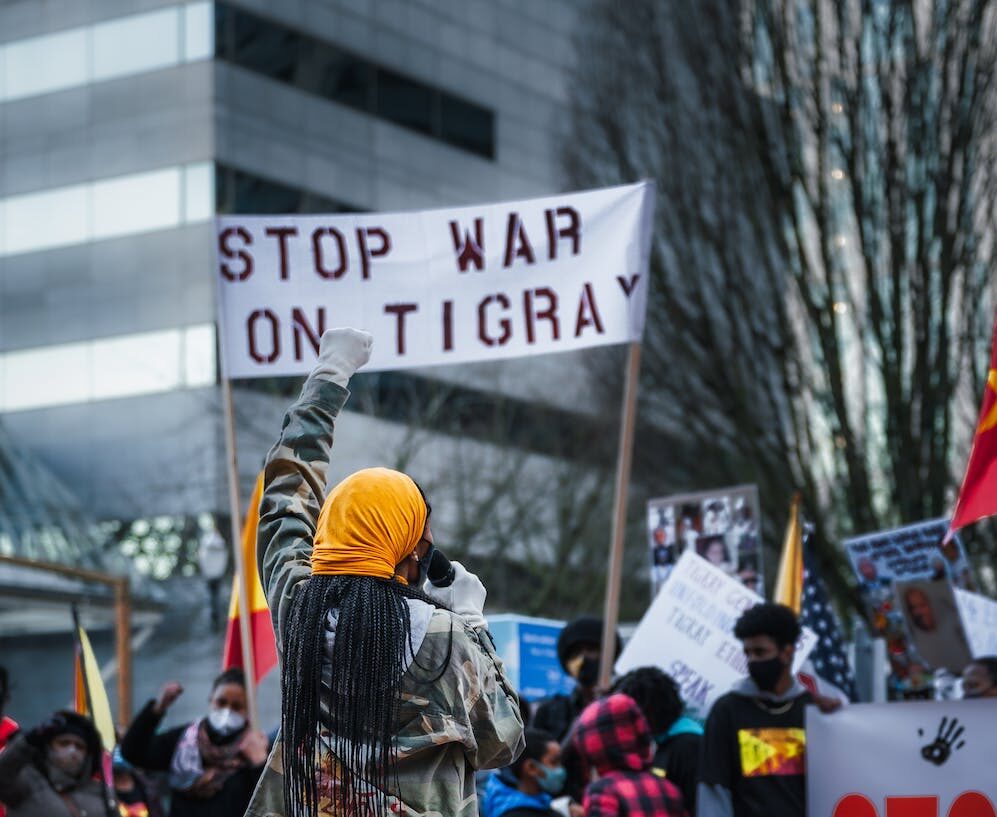
On the 2nd November 2022, after the African Union facilitated peace talks in Pretoria, the Ethiopian Federal Government and the Tigrayan People’s Liberation Front (TPLF) reached a historic agreement, which a few weeks ago seemed almost impossible. The two parties agreed to a permanent ceasefire to a conflict that had lasted two years, displaced millions of people and led to the deaths of up to half a million. But just how did this agreement come about, what does it tell us about the future of conflict resolution and is it likely to bring about a sustainable peace in Ethiopia?
The story behind the conflict though is one of fighting between Ethiopia’s Federal Government, led by Prime Minister Abiy Ahmed, and the Tigrayan People’s Liberation Front (TPLF), the regional government in the northern state of Tigray. Though, the issue is of course much more complex. Throughout the last two years of conflict, amongst the many recorded atrocities from both sides, allegations of ethnic cleansing and “weaponizing starvation” have been brought against Abiy’s forces, with Ethiopia’s Federal Government accused of preventing crucial humanitarian aid supplies from reaching Tigray.
In the context of such horrors and the Ethiopian Government’s huge military gains in the past few weeks, the possibility of a ceasefire between the two parties seemed distant, even when it was announced that talks were being brokered by the African Union (AU) in Pretoria. However, against the odds, an agreement calling for the “permanent cessation of hostilities” has been signed. Whilst a comprehensive peace deal remains distant, the preliminary agreement has set out a number of key accords, including the restoration of federal authority to Tigray, the representation of Tigray in federal institutions, the end of the Federal Government’s aid blockade and the disarmament of the TPLF. Whilst it is clear from this agreement and the context of Abiy’s recent military advance that these accords are very much on the Federal Government’s terms, some in Tigray may be encouraged by the Government’s apparent acknowledgement of the principle of federalism.
So why, after two years of bloody fighting has an agreement been reached now? Well for one thing, despite the strong advances of Federal forces in recent weeks, Abiy’s Government would still have been wary about the prospect of a Tigrayan counter-offensive, as happened earlier on the conflict. Likewise, some credit must be given to the African Union for brokering the settlement and the US for its diplomatic pressure in bringing the warring parties to the negotiating table.
However, whilst some have praised the diplomatic efforts of these actors, others have questioned why it has taken so long and cost so much to bring about this ceasefire. For one thing, whilst the Ethiopian Government has rejected perceived imperial demands by the US calling for the cessation of hostilities, the TPLF has been equally sceptical of the African Union’s involvement, accusing it of bias, due to the organisation’s headquarters in the Ethiopian capital Addis Ababa. Likewise, the UN has been markedly absent during the majority of the conflict, with Russia and China, a key ally and trading partner of Ethiopia, preventing the imposition of diplomatic pressure on the Ethiopian Government.
The role of the international community in Ethiopia’s conflict has thus raised huge questions about the future of conflict resolution and the Responsibility to Protect framework. For one thing, it has become clear that regional organisations, once seen as the international community’s greatest asset in conflict resolution, are becoming unable to escape accusations of bias and political motivations that have been levied against other powerful state and international actors. Likewise, with the absence of strong diplomatic pressure at the UN level, it appears that debates around conflict-resolution have taken an apparent and worrying neo-imperialist turn, with Dr Comfort Ero, president of the International Crisis Group, recently calling on the US to fulfil these coercive functions by withholding IMF and World Bank aid to Ethiopia, should Abiy’s Government fail to comply with the ceasefire agreement.
Whilst we shouldn’t become nostalgic for some imagined past of a diplomatic and impartial international community, it is clear what we need now is a unified, internationally-supported UN able to work with regional bodies to exert the diplomatic pressure needed to bring warring parties to the negotiating table and to prevent the reemergence of conflict thereafter. Such a partnership between the international and the regional could be seen in the mediation of Kenya’s 2007-8 post-election violence, where UN diplomatic pressure supported AU negotiation efforts in brokering a power-sharing agreement and bringing an end to the violence. Yet the current climate suggests a very different reality of a gridlocked UN, steeped in Security Council political tensions, from Ukraine to Taiwan, unable to provide the diplomatic pressure needed to help resolve conflicts. Instead, regional organisations and powerful states are stepping up to provide this kind of diplomatic pressure, leaving them open to attacks on their legitimacy that international bodies like the UN can more easily escape.
Moving back to Ethiopia, the question remains whether the ceasefire agreement can hold. One potential challenge comes from whether TPLF soldiers will obey their leaders’ calls to disarm, given the cost of this conflict for the Tigrayan people. However, reports in recent days of Tigrayan and Government forces sharing food and cigaretteshave brought hope that this peace settlement will be supported by soldiers on the ground. Likewise, fears raised by WHO Director General Tedros Adhanom Ghebreyesus that the Ethiopian Government was continuing its aid blockade, whilst still prevalent, have been partially eased by Government announcements that aid deliveries will begin again by “by end of the week”. The biggest fear lies in potential violence from Abiy’s ally Eritrea. Recent months have seen the Eritrean military pushing well into Tigrayan territory (likely at the request of Abiy’s Government), committing many well-documented war crimes in the process. As the Eritrean Government was not included in AU-mediated peace negotiations, it remains to be seen whether it will derail the negotiated settlement.
Thus, the future of Ethiopia remains uncertain, with a long and unpredictable road ahead to a sustainable peace. In the absence of UN leadership, pressure and support from regional organisations will likely be crucial in ensuring all parties uphold their commitment to peace. Yet whilst many challenges remain, at last a glimmer of hope has arrived.



Average Rating